Abstract
Binding of agonists to nicotinic acetylcholine receptors generates a sequence of changes that activate a cation-selective conductance. By measuring electrophysiological responses in chimeric alpha7/alpha3 receptors expressed in Xenopus oocytes, we have showed the involvement of the M2-M3 loop in coupling agonist binding to the channel gate. An aspartate residue therein, Asp-266 in the alpha7 subunit, was identified by site-directed mutagenesis as crucial, since mutants at this position exhibited very poor functional responses to three different nicotinic agonists. We have extended this investigation to another neuronal nicotinic receptor (alpha3/beta4), and found that a homologous residue in the beta4 subunit, Asp-268, played a similar role in coupling. These findings are consistent with a hypothesis that the aspartate residue in the M2-M3 loop, which is conserved in all homomer-forming alpha-type subunits and all neuronal beta-type subunits that combine to form functional receptors, is a major determinant of information transmission from binding site to channel gate in all neuronal nicotinic receptors.
Full text
PDF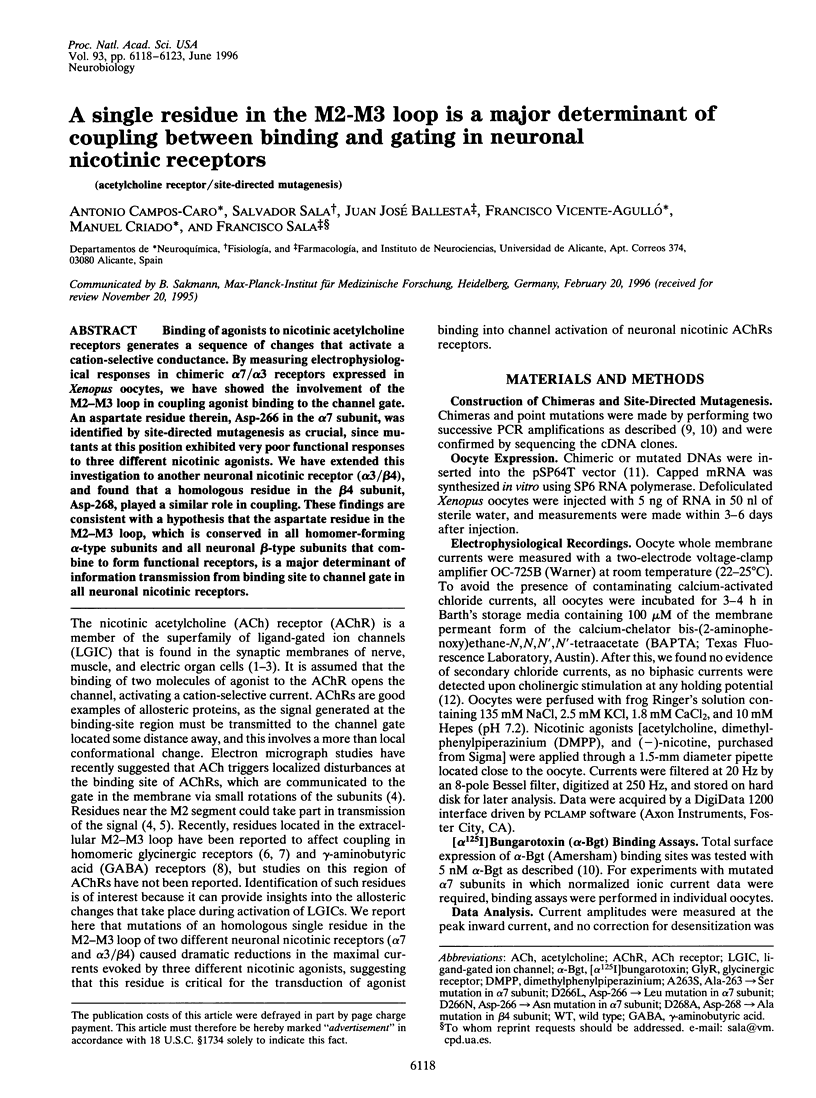
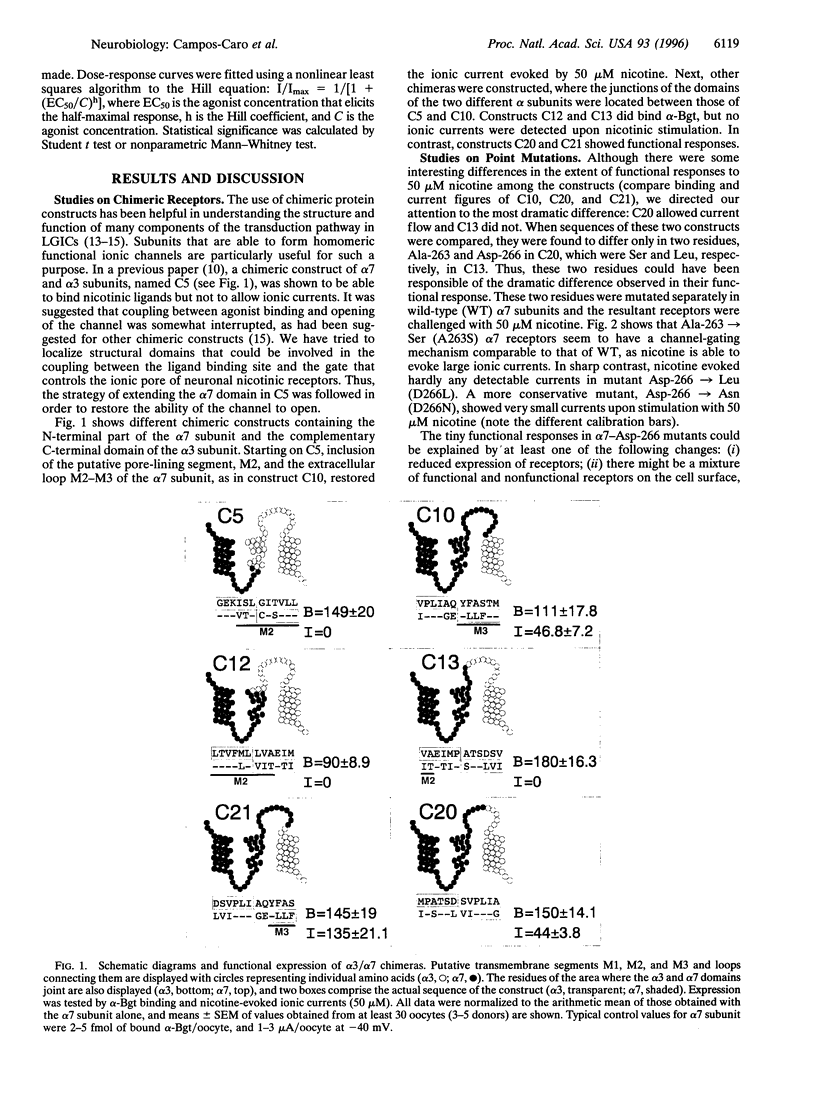
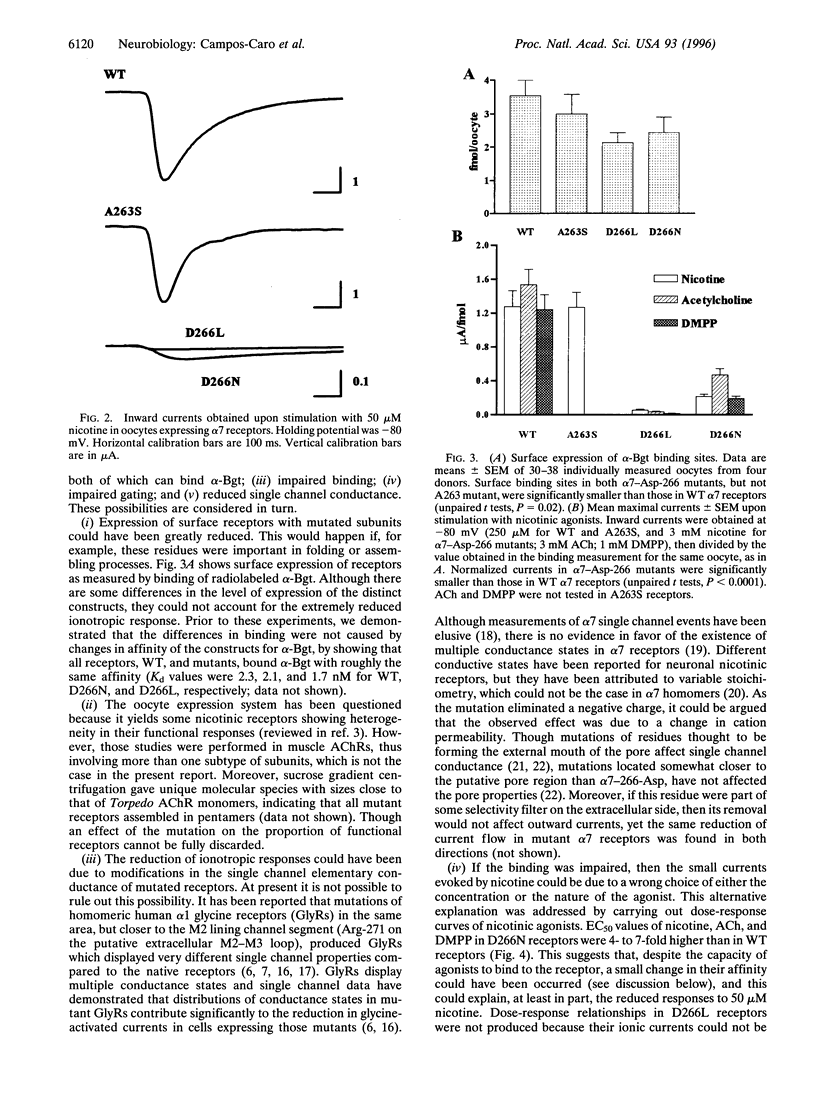
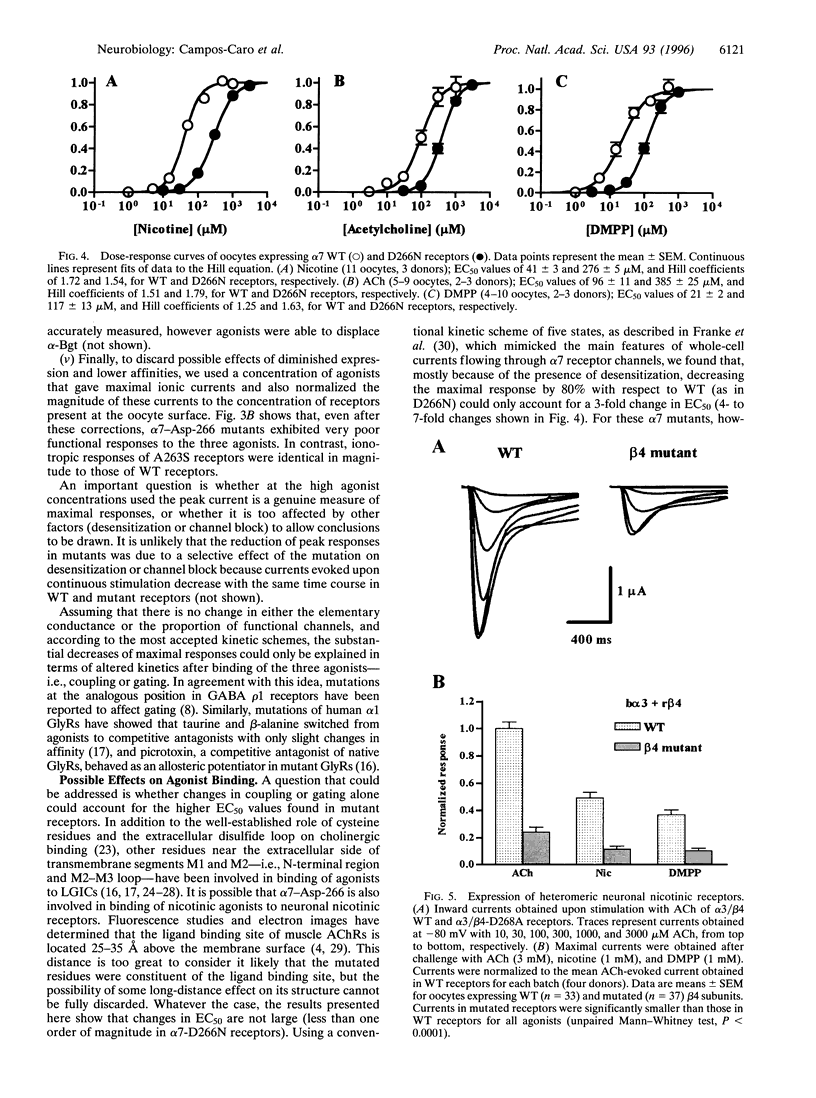
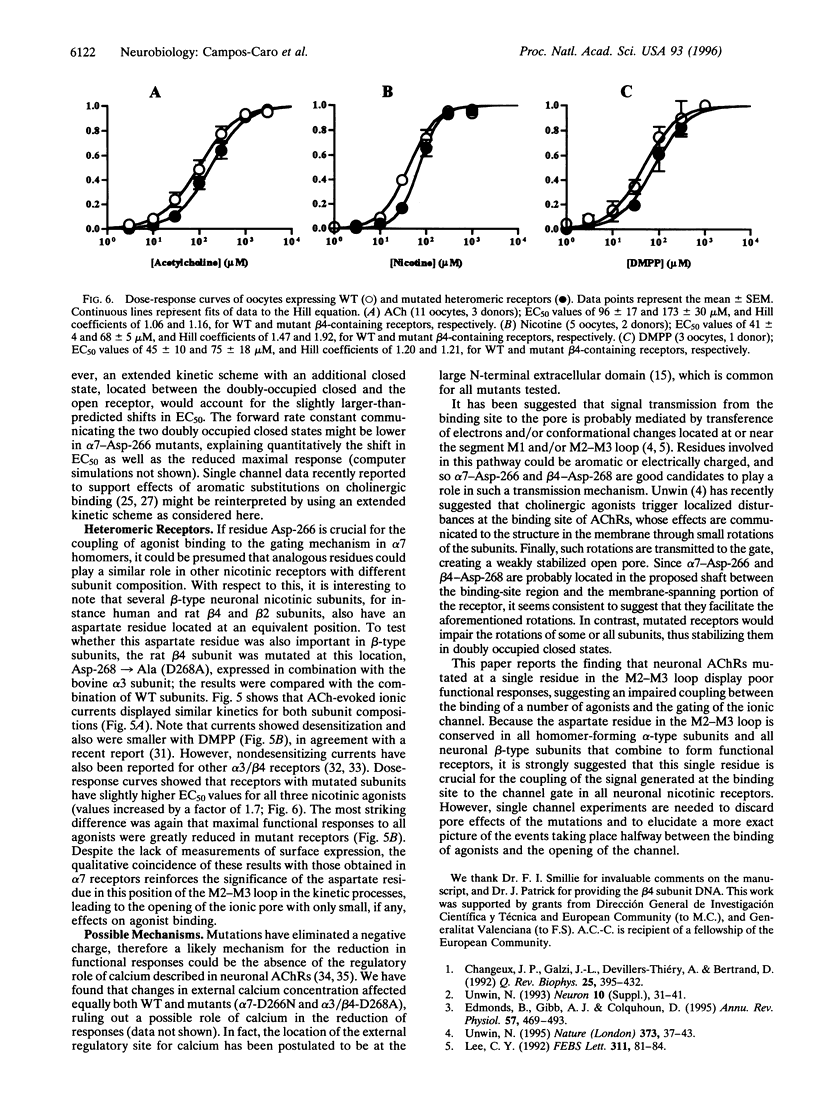

Images in this article
Selected References
These references are in PubMed. This may not be the complete list of references from this article.
- Amin J., Weiss D. S. GABAA receptor needs two homologous domains of the beta-subunit for activation by GABA but not by pentobarbital. Nature. 1993 Dec 9;366(6455):565–569. doi: 10.1038/366565a0. [DOI] [PubMed] [Google Scholar]
- Aylwin M. L., White M. M. Gating properties of mutant acetylcholine receptors. Mol Pharmacol. 1994 Dec;46(6):1149–1155. [PubMed] [Google Scholar]
- Cachelin A. B., Jaggi R. Beta subunits determine the time course of desensitization in rat alpha 3 neuronal nicotinic acetylcholine receptors. Pflugers Arch. 1991 Dec;419(6):579–582. doi: 10.1007/BF00370298. [DOI] [PubMed] [Google Scholar]
- Changeux J. P., Galzi J. L., Devillers-Thiéry A., Bertrand D. The functional architecture of the acetylcholine nicotinic receptor explored by affinity labelling and site-directed mutagenesis. Q Rev Biophys. 1992 Nov;25(4):395–432. doi: 10.1017/s0033583500004352. [DOI] [PubMed] [Google Scholar]
- Chen J., Zhang Y., Akk G., Sine S., Auerbach A. Activation kinetics of recombinant mouse nicotinic acetylcholine receptors: mutations of alpha-subunit tyrosine 190 affect both binding and gating. Biophys J. 1995 Sep;69(3):849–859. doi: 10.1016/S0006-3495(95)79959-3. [DOI] [PMC free article] [PubMed] [Google Scholar]
- Covernton P. J., Kojima H., Sivilotti L. G., Gibb A. J., Colquhoun D. Comparison of neuronal nicotinic receptors in rat sympathetic neurones with subunit pairs expressed in Xenopus oocytes. J Physiol. 1994 Nov 15;481(Pt 1):27–34. doi: 10.1113/jphysiol.1994.sp020416. [DOI] [PMC free article] [PubMed] [Google Scholar]
- Edmonds B., Gibb A. J., Colquhoun D. Mechanisms of activation of muscle nicotinic acetylcholine receptors and the time course of endplate currents. Annu Rev Physiol. 1995;57:469–493. doi: 10.1146/annurev.ph.57.030195.002345. [DOI] [PubMed] [Google Scholar]
- Eiselé J. L., Bertrand S., Galzi J. L., Devillers-Thiéry A., Changeux J. P., Bertrand D. Chimaeric nicotinic-serotonergic receptor combines distinct ligand binding and channel specificities. Nature. 1993 Dec 2;366(6454):479–483. doi: 10.1038/366479a0. [DOI] [PubMed] [Google Scholar]
- Franke C., Parnas H., Hovav G., Dudel J. A molecular scheme for the reaction between acetylcholine and nicotinic channels. Biophys J. 1993 Feb;64(2):339–356. doi: 10.1016/S0006-3495(93)81374-2. [DOI] [PMC free article] [PubMed] [Google Scholar]
- García-Guzmán M., Sala F., Sala S., Campos-Caro A., Criado M. Role of two acetylcholine receptor subunit domains in homomer formation and intersubunit recognition, as revealed by alpha 3 and alpha 7 subunit chimeras. Biochemistry. 1994 Dec 20;33(50):15198–15203. doi: 10.1021/bi00254a031. [DOI] [PubMed] [Google Scholar]
- Gotti C., Hanke W., Maury K., Moretti M., Ballivet M., Clementi F., Bertrand D. Pharmacology and biophysical properties of alpha 7 and alpha 7-alpha 8 alpha-bungarotoxin receptor subtypes immunopurified from the chick optic lobe. Eur J Neurosci. 1994 Aug 1;6(8):1281–1291. doi: 10.1111/j.1460-9568.1994.tb00318.x. [DOI] [PubMed] [Google Scholar]
- Gross A., Ballivet M., Rungger D., Bertrand D. Neuronal nicotinic acetylcholine receptors expressed in Xenopus oocytes: role of the alpha subunit in agonist sensitivity and desensitization. Pflugers Arch. 1991 Nov;419(5):545–551. doi: 10.1007/BF00370805. [DOI] [PubMed] [Google Scholar]
- Imoto K., Busch C., Sakmann B., Mishina M., Konno T., Nakai J., Bujo H., Mori Y., Fukuda K., Numa S. Rings of negatively charged amino acids determine the acetylcholine receptor channel conductance. Nature. 1988 Oct 13;335(6191):645–648. doi: 10.1038/335645a0. [DOI] [PubMed] [Google Scholar]
- Krieg P. A., Melton D. A. Functional messenger RNAs are produced by SP6 in vitro transcription of cloned cDNAs. Nucleic Acids Res. 1984 Sep 25;12(18):7057–7070. doi: 10.1093/nar/12.18.7057. [DOI] [PMC free article] [PubMed] [Google Scholar]
- Kusama T., Wang J. B., Spivak C. E., Uhl G. R. Mutagenesis of the GABA rho 1 receptor alters agonist affinity and channel gating. Neuroreport. 1994 Jun 2;5(10):1209–1212. doi: 10.1097/00001756-199406020-00012. [DOI] [PubMed] [Google Scholar]
- Langosch D., Laube B., Rundström N., Schmieden V., Bormann J., Betz H. Decreased agonist affinity and chloride conductance of mutant glycine receptors associated with human hereditary hyperekplexia. EMBO J. 1994 Sep 15;13(18):4223–4228. doi: 10.1002/j.1460-2075.1994.tb06742.x. [DOI] [PMC free article] [PubMed] [Google Scholar]
- Lee C. Y. Ligand-activated ion channels may share common gating mechanisms with the Shaker potassium channel. FEBS Lett. 1992 Oct 19;311(2):81–84. doi: 10.1016/0014-5793(92)81372-s. [DOI] [PubMed] [Google Scholar]
- Luetje C. W., Piattoni M., Patrick J. Mapping of ligand binding sites of neuronal nicotinic acetylcholine receptors using chimeric alpha subunits. Mol Pharmacol. 1993 Sep;44(3):657–666. [PubMed] [Google Scholar]
- Lynch J. W., Rajendra S., Barry P. H., Schofield P. R. Mutations affecting the glycine receptor agonist transduction mechanism convert the competitive antagonist, picrotoxin, into an allosteric potentiator. J Biol Chem. 1995 Jun 9;270(23):13799–13806. doi: 10.1074/jbc.270.23.13799. [DOI] [PubMed] [Google Scholar]
- Mishina M., Tobimatsu T., Imoto K., Tanaka K., Fujita Y., Fukuda K., Kurasaki M., Takahashi H., Morimoto Y., Hirose T. Location of functional regions of acetylcholine receptor alpha-subunit by site-directed mutagenesis. 1985 Jan 31-Feb 6Nature. 313(6001):364–369. doi: 10.1038/313364a0. [DOI] [PubMed] [Google Scholar]
- Mulle C., Léna C., Changeux J. P. Potentiation of nicotinic receptor response by external calcium in rat central neurons. Neuron. 1992 May;8(5):937–945. doi: 10.1016/0896-6273(92)90208-u. [DOI] [PubMed] [Google Scholar]
- Murray N., Zheng Y. C., Mandel G., Brehm P., Bolinger R., Reuer Q., Kullberg R. A single site on the epsilon subunit is responsible for the change in ACh receptor channel conductance during skeletal muscle development. Neuron. 1995 Apr;14(4):865–870. doi: 10.1016/0896-6273(95)90230-9. [DOI] [PubMed] [Google Scholar]
- Papke R. L., Boulter J., Patrick J., Heinemann S. Single-channel currents of rat neuronal nicotinic acetylcholine receptors expressed in Xenopus oocytes. Neuron. 1989 Nov;3(5):589–596. doi: 10.1016/0896-6273(89)90269-9. [DOI] [PubMed] [Google Scholar]
- Rajendra S., Lynch J. W., Pierce K. D., French C. R., Barry P. H., Schofield P. R. Mutation of an arginine residue in the human glycine receptor transforms beta-alanine and taurine from agonists into competitive antagonists. Neuron. 1995 Jan;14(1):169–175. doi: 10.1016/0896-6273(95)90251-1. [DOI] [PubMed] [Google Scholar]
- Rajendra S., Lynch J. W., Pierce K. D., French C. R., Barry P. H., Schofield P. R. Startle disease mutations reduce the agonist sensitivity of the human inhibitory glycine receptor. J Biol Chem. 1994 Jul 22;269(29):18739–18742. [PubMed] [Google Scholar]
- Revah F., Bertrand D., Galzi J. L., Devillers-Thiéry A., Mulle C., Hussy N., Bertrand S., Ballivet M., Changeux J. P. Mutations in the channel domain alter desensitization of a neuronal nicotinic receptor. Nature. 1991 Oct 31;353(6347):846–849. doi: 10.1038/353846a0. [DOI] [PubMed] [Google Scholar]
- Sine S. M., Quiram P., Papanikolaou F., Kreienkamp H. J., Taylor P. Conserved tyrosines in the alpha subunit of the nicotinic acetylcholine receptor stabilize quaternary ammonium groups of agonists and curariform antagonists. J Biol Chem. 1994 Mar 25;269(12):8808–8816. [PubMed] [Google Scholar]
- Séguéla P., Wadiche J., Dineley-Miller K., Dani J. A., Patrick J. W. Molecular cloning, functional properties, and distribution of rat brain alpha 7: a nicotinic cation channel highly permeable to calcium. J Neurosci. 1993 Feb;13(2):596–604. doi: 10.1523/JNEUROSCI.13-02-00596.1993. [DOI] [PMC free article] [PubMed] [Google Scholar]
- Tomaselli G. F., McLaughlin J. T., Jurman M. E., Hawrot E., Yellen G. Mutations affecting agonist sensitivity of the nicotinic acetylcholine receptor. Biophys J. 1991 Sep;60(3):721–727. doi: 10.1016/S0006-3495(91)82102-6. [DOI] [PMC free article] [PubMed] [Google Scholar]
- Unwin N. Acetylcholine receptor channel imaged in the open state. Nature. 1995 Jan 5;373(6509):37–43. doi: 10.1038/373037a0. [DOI] [PubMed] [Google Scholar]
- Unwin N. Neurotransmitter action: opening of ligand-gated ion channels. Cell. 1993 Jan;72 (Suppl):31–41. doi: 10.1016/s0092-8674(05)80026-1. [DOI] [PubMed] [Google Scholar]
- Valenzuela C. F., Weign P., Yguerabide J., Johnson D. A. Transverse distance between the membrane and the agonist binding sites on the Torpedo acetylcholine receptor: a fluorescence study. Biophys J. 1994 Mar;66(3 Pt 1):674–682. doi: 10.1016/s0006-3495(94)80841-0. [DOI] [PMC free article] [PubMed] [Google Scholar]
- Vernino S., Amador M., Luetje C. W., Patrick J., Dani J. A. Calcium modulation and high calcium permeability of neuronal nicotinic acetylcholine receptors. Neuron. 1992 Jan;8(1):127–134. doi: 10.1016/0896-6273(92)90114-s. [DOI] [PubMed] [Google Scholar]
- Wong E. T., Holstad S. G., Mennerick S. J., Hong S. E., Zorumski C. F., Isenberg K. E. Pharmacological and physiological properties of a putative ganglionic nicotinic receptor, alpha 3 beta 4, expressed in transfected eucaryotic cells. Brain Res Mol Brain Res. 1995 Jan;28(1):101–109. doi: 10.1016/0169-328x(94)00189-l. [DOI] [PubMed] [Google Scholar]



